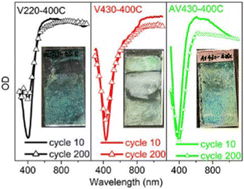2D vanadium oxide inverse opal films: cycling stability exploration as an electrochromic active electrode†
Abstract
2D vanadium oxide inverse opal (IO) films with a porous array were fabricated via a modified “dynamic hard template infiltration strategy” using various sizes of sacrificial polystyrene spheres (PS), followed by calcination under various conditions. Effects of pore size and phases on electrochromic cycling were explored by combining electrochemical cyclic voltammetry (CV) and chronoamperometry (CA). The results showed that the pore size has an important double influence on electrochromic cycling stability; on the one hand, pores buffered stress-induced pulverization for which the appropriate pore size under present conditions was found to be 141 nm. On the other hand, faster chemical dissolution in the film of a smaller pore size (V220-400C) led to accelerated fading in electrochromic cycling in contrast to its bigger pore size counterpart. In contrast, small amounts of V6O13 and non-stoichiometric V6O13+y in the V2O5 IO film were found to greatly improve cycling stability in both electrochemical CV and electrochromic cycles. This improved cycling stability was attributed to good conductivity of V6O13+y which greatly alleviated pulverization and chemical dissolution in V2O5 IO films by minimizing the phase coexistence upon cycling. The correlation between electrochemical cycling stability and electrochromic cycling stability is also discussed.

- This article is part of the themed collections: Celebrating International Women’s day 2024: Women in Materials Science and Stability of Optoelectronic Materials and Devices


 Please wait while we load your content...
Please wait while we load your content...